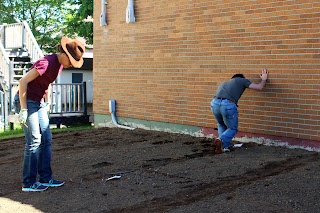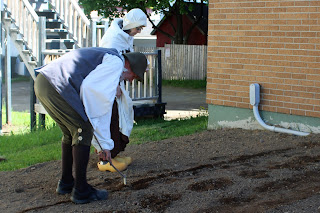Sunday, June 25, 2017
Wednesday, June 21, 2017
Tuesday, June 20, 2017
Monday, June 19, 2017
Accessible Gardening
Anyone, if they want to, can garden. Appropriate design, that is design that understands and incorporates the wants and needs of the individual, is the key.
Gardening is the act or, as I prefer the art, of growing plants. While not all gardens are works of art, the designer, using basic design principles, incorporates the seven design elements (line, shape, form, space, texture, value and colour) when creating a garden.
What plants the gardener grows is a personal choice and the variety of possibilities is vast. The most successful gardens embrace diversity and employ a wide palette when laying out a garden.
All too often, people when they think about a garden, visualize flowers and-or vegetables planted directly into the ground in neat and straight rows.
There is nothing wrong with this image and many successful gardens adopt this design. However, it is only one of a number of ways plants can be grown.
This article begins an ongoing series that will look at how to create accessible gardens. Future articles will explore specific design considerations, garden tools specifically adapted to enable people to enjoy all gardening has to offer.
Gardens generally consist of two components, hardscape and softscape. Softscape is the living plants the gardener grows, vegetables, herbs, tress and so on.
Hardscape is the non-living elements, benches, ornaments, lights, paths and so on. Today and next week we will focus on hardscape. For the home garden, a pathway enables people with varying mobility concerns, to experience the garden, directly.
The minimum width of an unobstructed pathway should be 0.90 m. The minimum width of a two-way wheelchair traffic passage is 1.50 m. The preferable width is 1.80 m. In the home garden, it may not be necessary to build a path that caters to two-way traffic.
The slope of an accessible path should not exceed 1:20. Pathways with a slope of more than 1:20 should be designed as ramps. A ramp may be needed if the property is sloped.
What materials must be used when creating an accessible pathway?
First the surface of the pathway needs to be well constructed and must provide firm, non-slip, level access. Do not use loose materials, such as gravel.
Asphalt is a low cost and low maintenance material that provides durability. Weed maintenance may be necessary as over the years asphalt may crack. Asphalt, by itself, is not attractive, however, it can be surfaced with other materials to increase its visual appeal.
Asphalt paths may also act as a heat sink which can play both a positive and negative role in a garden.
Tarmac is another option. Tarmac refers to a technique or approach to paving that involves crushed rock or gravel held together with heated tar.
There are other alternatives to asphalt and tarmac and I suggest taking time and reviewing the overall garden plan and the site itself before deciding on any material.
Next week, we will continue our look at hardscape and focus on other non-living elements that will increase the garden’s accessibility so that anyone can enjoy the benefits available.
originally published in my From The garden column in the Campbellton tribune.
Thursday, June 15, 2017
Wednesday, June 14, 2017
Today's Greenhouse Planting
June 14, 2017.
Planted early jalapeno, sweet long peppers, and sweet bell peppers in the greenhouse today. 24 plants in total.
Planted early jalapeno, sweet long peppers, and sweet bell peppers in the greenhouse today. 24 plants in total.
Saturday, June 10, 2017
Sunday, June 4, 2017
Compost
Healthy soil means healthy plants. How do you keep your soil healthy? Simple, use an organic fertilizer at the end and the beginning of each gardening season. Where can I get organic fertilizer? Easy enough, make your own from material already at hand.
I am talking about compost which is an excellent organic fertilizer
Now you can go out and buy compost, if you do choose an organic compost. However, a cheaper way to get compost is to make your own.
I would be amiss to mention using well-rotted manure to feed the soil. Sheep manure, purchased locally, is my choice when no other source of organic fertilizer is available.
Making your own compost is a straightforward process. All the material needed are right at hand. Food scrapes, not bone or meat, but vegetables are excellent compostable material.
You can also add grass clippings to the mix. Besides adding grass clipping to the compost pile leave the bulk of the clippings where they fall when you cut the lawn. This is a cheap and healthy way to feed the lawn.
Composting is an excellent way to recycle material that might otherwise end up being transported to a landfill. There is no need to add to the mountains of waste we already toss out.
Composting is how you can complete the growing cycle. You put compost on your vegetable garden to help the plants grow; you harvest the plants for your meals and then put the scarps in the compost which you then put on your garden to help the plants grow. This closed circuit approach reduces waste and produces healthy food for you and your family.
What can you compost? The following information provides you with a list of items that can go into your compost pile.
From Your Garden:
Leaves (chopped - to speed their breakdown)
Grass (not wet)
Plants & Weeds (without ripe seeds)
Old potting soil
Soft plant stems
From Your Kitchen.
Coffee grounds and filters
Fruit scraps
Vegetable trimmings
Crushed egg shells
Tea bags
Shredded paper.
The following items should not be placed into the compost:
Dairy products including cheese
Meat, fish (including sauces) and bones
Plastics
Metals
Fats and oils
Pet waste
A perfect mixture of material for the compost bin consists of ½ brown (carbon-based material) and ½ green (nitrogen-based) materials by weight.
Remember that a successful gardener builds soil and compost enables you to do that work.
There are a number of ways to keep the organic material as it turns to compost. For the average yard, if appearance is a priority, there are a number of options commercially available. Compost needs to be turned over, so keep this in mind when buying one.
This simplest way to make a compost pile is to dig a pit in the ground and add the material. This compost pit will need to be turned over on a regular basis. A pitch fork is a perfect tool to accomplish this task.
A better way is to build your own composter. There are plans on the Internet and in books available at the public library. Pick a plan that suits you and compost away.
Subscribe to:
Posts (Atom)
Native Plants
There are two projects happening here in Campbellton that have me turning to the subject of native plants. When we are discussing native pl...
-
I was at the Galerie Restigouche Gallery the other night and among other topics, I was asked when is the best time to get seeds started ind...
-
I am working with a small group; introducing them to permaculture design as we develop a plan for the local community garden. Perm...
-
The backyard classroom offers lessons in botany, biology and entomology. Plant and insect identification helps your child understand the ...








